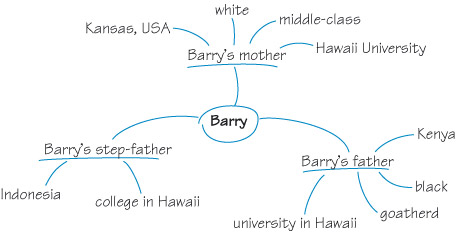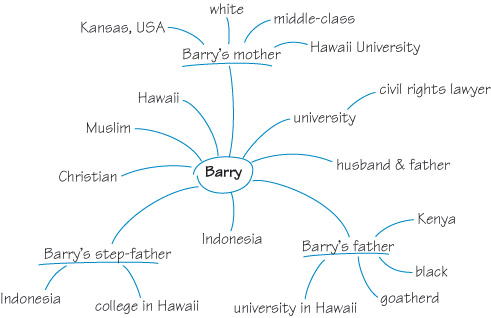4.1 Piecing together an identity
As you read the case study, concentrate on the different social groups that an individual, known as Barry, seems to belong to, and the various cultures he has a connection through his family members. You should look out for places these family members have lived but also their education, class and ethnic origin. We have presented some of this information in the form of a spider diagram (Figure 7) which puts ‘Barry’ in the middle and then shows his family members around the outside.
Barry
Barry’s father He was born in Kenya and for a time worked as a goatherd in his village. However, he showed ability in his schooling and with the support of his teacher and family he won an educational scholarship to the USA. He was the first black student at the University of Hawaii. He had little contact with Barry after the age of 2 as he returned to Kenya to be a senior government adviser.
Barry’s mother She was born in Kansas, USA, from a white middle-class background. She had a good education, a comfortable home and also went to university in Hawaii where she met her husband to be, Barry’s father. However the two were divorced when Barry was young and his mother later remarried.
Barry’s step-father He was from Indonesia but was also studying at college in Hawaii, which is where he met Barry’s mother. When Barry was 6, the family moved from Hawaii to Jakarta, Indonesia, to live.
What do we know so far? Barry has lots of different cultural influences from his parents. These include college or university education, Kenyan-African culture, Indonesian culture, a middle-class American background on his mother’s side at least, and more than one ethnic identity.
The activity coming up next gives you some more information about Barry and helps you to piece together a little more of his identity.
Activity 4 Piecing together an identity
Copy out the spider diagram in Figure 7.
Don’t worry about making an exact copy, but do leave some space around it so you can add more branches. Now read the following information and, based on it, add to the spider diagram, showing the main influences on Barry’s identity. As you will see the emphasis is shifting now from Barry’s parents to Barry himself.
Barry’s middle name is Hussein. He lived in Hawaii until he was 6 and then lived in Indonesia. His first school was a Catholic school but his first registered religion was Muslim after his father. He changed to Christianity later on. At 10 he moved back to Hawaii and was raised by his white grandmother, who paid for him to be privately educated. He went to Columbia University, then Harvard Law School. After college he became a civil-rights lawyer. He also married and became father to two children.
Comment
My Comment
So now you know more about Barry. In addition to a potential connectedness with a number of ethnic groups, he also has connections to different religions. His varied experiences of different types of education and his choice of career all served to expose him to cultural groups with different attitudes and beliefs.
Figure 8 shows how we completed the identity diagram for Barry. You will probably have drawn yours differently, but we hope you have shown a few of the same influences. I also hope that you have found drawing spider diagrams useful. It can be an important part of taking notes from your reading and a powerful means of shaping what you have read on the page into information that is organised visually, in a way which makes sense to you. You can also use spider diagrams when planning essays or other written tasks. Some people find them a really helpful way of starting off a piece of writing. Often the spider diagram can assist you to structure your initial thoughts in a way that written notes on their own might not do.


